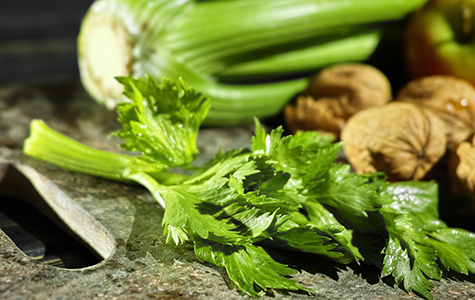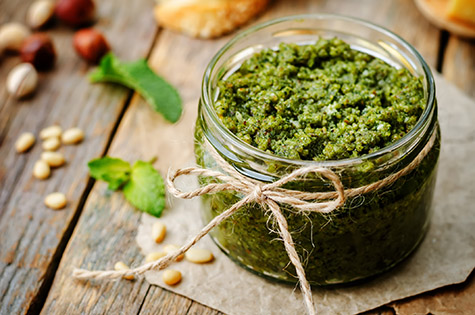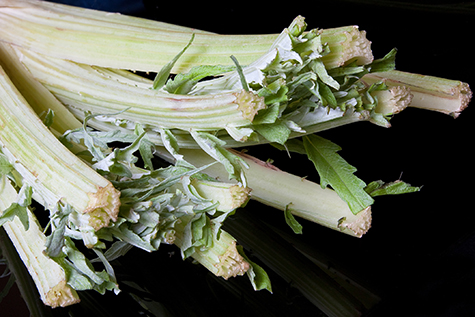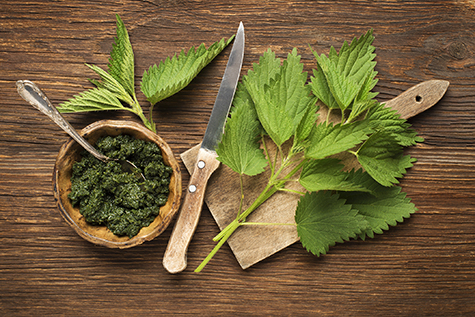Presto! Pesto Adds Flavor and Superpowers


Who doesn’t love pesto, the uncooked sauce most associated with the city of Genoa in Northern Italy? The pesto most of us have tried is made with fresh basil that’s been pounded and mixed with super-diced garlic, Parmesan cheese, pine nuts, then blended with extra virgin olive oil. Basil pesto imparts a beautiful green color on pasta and is a great spread on Italian bread.
The dark green basil leaves are nutritional stars, because they are full of compounds that stabilize blood sugar levels and antioxidants that help protect cells from free radical damage.
The garlic in pesto contains allicin, an important compound that is said to have excellent antibacterial, antiviral, antifungal and antioxidant properties. Allicin can also contribute to healing of the circulatory, digestive and immunological systems.
Extra virgin olive oil enhances heart health by lowering ‘bad’ cholesterol.
What you may not know is that there are any number of pestos you can make yourself, many of them inspired by ingredients and cuisines from around the world. In my Age Beautifully Cookbook there is a recipe for Kale-Cashew Pesto that deliciously combines sweet cashew nuts with superfood kale. Then, there’s my recipe for Nettle Pesto, which can help calm allergies due to its anti-inflammatory and immune boosting properties.
Here are some pesto recipes that will add international flavor to many mealtime favorites. They’re easy to prepare (no cooking!) and deliciously different.
Immune-Boosting Moringa Pesto
The Moringa tree is native to the southern Himalayas, but it also grows in Thailand, Indonesia and Africa. A hardy plant, moringa leaves help to balance blood sugar levels and contain a chemical called Beta-sitosterol, which is known to block out LDL or ‘bad’, artery-clogging cholesterol. Beta-sitosterol has also been shown to be anti-inflammatory and can reduce allergies. Moringa is also high in fiber and has significant amounts of protein, calcium and vitamin C. You can buy dried moringa leaves online at Amazon or Thrive or fresh on A Healthy Leaf websites.
Moringa Pesto
Ingredients
½ cup moringa leaves, removed from the stems*
½ cup fresh basil leaves (or arugula)
½ cup of Italian flat leaf parsley
¼ cup toasted pine nuts
1 Tbs. fresh lemon juice
2 cloves of garlic, peeled
½ cup Pecorino, Romano or Parmesan cheese
Pinch of freshly ground black pepper
1/3 cup of extra virgin oil
Himalayan salt to taste (optional)
*If you can’t find fresh moringa, use ¼ cup of dried or powdered and increase the basil to 1 cup, or replace the moringa leaves with spinach leaves.
Procedure
- Add all ingredients, except olive oil, to the bowl of a food processor.
- Pulse repeatedly until everything is well-minced and blended.
- Leave processor in the ‘on’ position and slowly drizzle in the olive oil until well-blended.
- Taste for seasoning.
- Cover tightly and refrigerate overnight.
Walnuts Add Superpowers
Walnuts are one of the best foods for you. Where to begin? They are highest in omega-3 fatty acids of any nuts which helps reduce plaque in the arteries and is beneficial for brain function. They contain an amino acid called L-arginine, which is also good for the vascular system. They are high in antioxidants. Walnuts are rich in protein, fiber, calcium, magnesium, phosphorous and manganese. The light, fresh flavor of the celery leaves goes well with the rich flavor of the walnuts.
 Celery Leaf Walnut Pesto
Celery Leaf Walnut Pesto
Ingredients
2 cups lightly packed celery leaves* (from 1-2 large bunches)
2 cloves garlic
¼ tsp. sea salt
½ cup walnut halves and pieces
½ cup shredded Parmesan Cheese
Juice and zest of 1 lemon
½ cup extra-virgin olive oil
Crushed red pepper, additional walnuts and/or grated Parmesan; optional
*Watercress would be a delicious alternative.
Procedure
- Add the celery leaves, garlic, salt, walnuts, Parmesan and lemon juice to a blender or food processor.
- Pulse to combine.
- With the processor in the ‘on’ position, slowly pour in the olive oil, pausing to scrape down the sides of the bowl as needed, until smooth.
- Serve in a bowl as spread for flatbread, to dip fresh vegetables or use as a sauce for pasta or in any recipe that calls for pesto.
Mint Brings in Indian Influence
There’s something about fiery curries in Indian food that pairs wonderfully with mint. Plus, mint aids digestion, perks you up when you’re dragging, and can help clear congestion in the nose and sinuses. This pesto can be spread on Indian flat bread, stirred into soups or mixed in with steamed cauliflower and potatoes for a memorable side dish.
 Indian Mint Pesto
Indian Mint Pesto
Ingredients
1 cup tightly packed mint leaves
1 Tbsp. seeded, finely chopped jalapeños
½ tsp. curry powder
2 Tbsp. finely chopped Vidalia or other sweet onion
½ tsp. grated fresh ginger
1 Tbsp. lemon juice
2 Tbsp. almond butter (or ¼ cup crushed almonds)
Procedure
- Add all ingredients into a blender or food processor.
- Purée until smooth, about 25-30 seconds.
- Season with sea salt to taste.
Power Pesto Goes Vegan
My recipe for Power Pesto has a similar consistency to the classic Genoese version, but it packs a nutritional wallop with powerful super foods. Spirulina is a member of the microalgea family, commonly known as ‘sea vegetables.’ It’s loaded with chlorophyll protein, beta carotene (great for skin and eyes) and contains a pigment called phycocyanin, which has anti-inflammatory and anti-oxidant properties. You can find spirulina powder in health food stores or on Amazon. This is a vegan pesto and would taste delicious on spiralized vegetables, spaghetti squash or fish fillets.
Power Pesto
Ingredients
3 cloves of garlic, peeled
¼ cup walnut halves and pieces
1 Tbsp. ground flax seed
2 cups lightly packed baby spinach (or arugula) leaves
2 cups torn kale leaves, lightly packed
1 Tbsp. spirulina powder
1 tsp. grated lemon zest
2 Tbsp. lemon juice
¼ tsp. sea salt
¼ tsp. red pepper flakes
½ cup extra virgin olive oil
Procedure
- Place garlic, walnut pieces and flax seed in the bowl of a blender or food processor and pulse until evenly chopped.
- Add the spinach, kale, spirulina and lemon zest; pulse until finely chopped, scraping the sides of the bowl occasionally until fully incorporated.
- Add the lemon juice, salt and pepper flakes.
- Turn on the blender or food processor and pour the olive oil in a thin stream.
- May be served cold or warmed.
Cardoons Make A Play For Pesto
I had to refer to my copy of The New Food Lover’s Companion to find out about cardoons (also known as cardoni). It says, “Cardoon tastes like a cross between artichoke, celery and salsify. This delicious vegetable is very popular in France, Italy and Spain.” Cardoons look like large, flat leaves of celery and were enjoyed in ancient Rome. Cardoons are high in potassium, calcium and iron. They’re a little hard to find here, but you can order seeds and live plants online. If you ever see them at a farmers market, buy them! Now you have a recipe.
Fresh out of cardoons? Try celery root (much easier to find in markets). Take 2 bulbs (or about
1 lb.) and scrub well. Then trim the top and bottom. Remove skin with a vegetable peeler, cut into 1 inch cubes, and prepare as you would for the cardoons.
 Cardoon Pesto
Cardoon Pesto
Ingredients
1 lb. cardoons (or celery root), peeled and sliced into 1” pieces
2 cloves peeled garlic
1/3 cup toasted pine nuts or almonds
¼ cup tightly packed flat leaf or Italian parsley
½ tsp. lemon zest
2 tsp. lemon juice
¼ tsp. sea salt
1/3 cup extra virgin olive oil
½ cup shredded Parmesan cheese
Fresh ground black pepper to taste
Procedure
- Place the cardoon (or celery root) pieces in a pot of lightly salted water and bring to a boil.
- Reduce heat and simmer until tender, 30-40 minutes.
- Drain thoroughly and pat dry.
- In a blender or food processor, add together the garlic and pine nuts; pulse till finely chopped.
- Add the cardoons, parsley, lemon zest, 1 tsp. lemon juice, sea salt and black pepper; pulse until it becomes a coarse purée, stopping to scrape down the sides.
- Add the Parmesan cheese.
- With the processor on, drizzle in the olive oil, then remaining tsp. of lemon juice.
- Additional salt and fresh ground pepper to taste.
Pistachios Meet Fava Beans For Pesto
No need for a passport to find the ingredients of this pesto, but it’s delicious and packed with FoodTrients. Pistachios, like most nuts, contain fiber, protein, vitamins and minerals. They contain healthy fats for cardiovascular health and antioxidants lutein and zeaxanthin that protect eyes from free radicals and sunlight. Fava beans contain high concentrations of thiamin, vitamin K, vitamin B-6, potassium, copper, selenium, zinc and magnesium.
Serve this pesto as a spread on crackers or artisan toast, or as a dip for raw vegetables. Toss with large tube pasta such as rigatoni.
Pistachio and Fava Bean Pesto
Ingredients
1 ½ cups shelled, unsalted dry roasted pistachios
1 lb. fresh fava beans (or lima beans)
2 cloves of garlic, peeled
2 Tbsp. chopped sweet onion
½ cup canned Great Northern, cannellini or other white beans
½ cup tightly packed arugula
1 Tbsp. lemon juice
¼ tsp. sea salt
Fresh ground pepper to taste
½ cup extra virgin olive oil
Procedure
- Blanch the fava beans in lightly salted water for 2 minutes. Drain and cool.
- In a blender or food processor, pulse the garlic and onion into a coarse paste.
- Drain and rinse the canned white beans.
- Add the pistachios, fava beans, white beans, arugula and lemon juice; pulse until well blended. Scrape down the sides as needed.
- With the processor on, drizzle in the olive oil.
- Add salt and pepper to taste.




